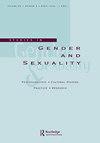回复讨论的幻影阴茎:外推神经科学和运用想象力的跨性别男性的性体现
Q3 Social Sciences
引用次数: 0
摘要
在这篇回复文章中,我与八篇论文的作者进行了对话,这些论文是对我的论文“幻影阴茎:外推神经科学和运用想象力的跨性别男性性体现”的回应。我非常感谢受访者所做的贡献:他们从学术和专业的角度来讨论幻影阴茎对跨性别男性的体现和性行为的潜在影响。雷曼向我们指出了阴茎在视觉文化中具有讽刺意味的扩散和管制。Gherovici, Charlap, Harris和Weil深入研究了精神分析和哲学,将思想,身体,性别,性,阳具,欲望,情感和主观性的概念引入到跨幻像体验中。医学和神经科学的观点由Hontscharuk, Alba和Schechter, McGeoch和Ramachandran以及Case代表,他们都将讨论建立在身体组织和神经回路上。跨幻阴茎现象是基于生理、心理体现和文化介导的。为了探讨跨性别男性的身体舒适和性快感,我的论文探讨了三种幻象:幻阴茎存在、幻阴茎性感感觉和意志幻阴茎。本文章由计算机程序翻译,如有差异,请以英文原文为准。
Reply to Discussions of Phantom Penis: Extrapolating Neuroscience and Employing Imagination for Trans Male Sexual Embodiment
ABSTRACT In this reply essay, I engage in dialogue with the authors of the eight papers submitted in response to my paper, “Phantom Penis: Extrapolating Neuroscience and Employing Imagination for Trans Male Sexual Embodiment.” I deeply appreciate the respondents’ contributions: a panoply of academic and professional perspectives to this discussion of the potential of phantom penis for transgender men’s embodiment and sexuality. Lehman points us to the ironic proliferation and regulation of penises in visual culture. Gherovici, Charlap, Harris, and Weil delve into psychoanalysis and philosophy, engaging concepts of mind, body, gender, sexuality, phallus, desire, affect, and subjectivity, extrapolated to trans phantom experience. Medical and neuroscientific perspectives are represented by Hontscharuk, Alba, and Schechter, by McGeoch and Ramachandran, and by Case, who all ground the discussion in bodily tissue and neural circuitry. The phenomenon of trans phantom penis is based in the physiology, psychically embodied, and culturally mediated. In an attempt to address bodily comfort and sexual pleasure for trans men, my paper pursues three phantoms: phantom penis presence, phantom penile erogenous sensation, and volitional phantom penis.
求助全文
通过发布文献求助,成功后即可免费获取论文全文。
去求助
来源期刊

Studies in Gender and Sexuality
Social Sciences-Gender Studies
CiteScore
0.80
自引率
0.00%
发文量
15
期刊介绍:
Beginning in the final two decades of the 20th century, the study of gender and sexuality has been revived from a variety of directions: the traditions of feminist scholarship, postclassical and postmodern psychoanalytic theory, developmental research, and cultural studies have all contributed to renewed fascination with those powerfully formative aspects of subjectivity that fall within the rubric of "gender" and "sexuality." Clinicians, for their part, have returned to gender and sexuality with heightened sensitivity to the role of these constructs in the treatment situation, including the richly variegated ways in which assumptions about gender and sexuality enter into our understandings of "normality" and "pathology."
 求助内容:
求助内容: 应助结果提醒方式:
应助结果提醒方式:


